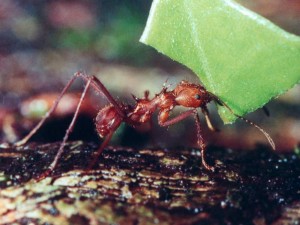I’ve always admired ants: they’re industrious, organized, and cooperative. Unlike humans, they’re unselfish. Unlike Congress, they get things done. Ants don’t have to receive orders: each one knows what to do, and does it.
Among the most interesting and ubiquitous species here in Costa Rica are the Leafcutters. They snip the leaves with their tiny serrated mandibles, and ferry the pieces back to the nest, like an endless flotilla of ships with bright green sails. At home, they slobber all over the leaves, chew them up, convert them to a fungus, and finally, integrate the fungus into their living structure, to form an edible dwelling.
We thought they were fun to watch as they transported their movable feast, until they began carrying off leaves from our garden. The minuscule movers can carve up and spirit away all of the leaves on a tree within 24 hours, although the small colonies around our house focused mostly on our shrubs, strawberries and collard greens. No amount of homemade chili and garlic infusion could keep them from our veggies, to our dismay. We reluctantly bought a commercial pesticide. It came in the form of little green pellets, which, as directed, we placed on the trail from the plants to the anthill. As we expected, the ants picked up the poison and carried it to their doom.
Another ant found in profusion here is the infamous fire ant, or, as I like to think of them, jaws-of-steel. These fiery fiends are highly organized when it comes to attacking their prey. According to an entomologist friend, they mount the quarry rapidly, like Lilliputians on Gulliver, not biting until they’re all aboard. Once they’re in place, the little leader sends out a signal to bite, in the form of pheromones, and they begin the assault.
Two days ago, Jack reported that some ants were on the march along the kitchen side of the house. “They’re all leaving,” he said. “Heading for the field.”
“That’s nice,” I’d said, watching him rummage through our garden supplies.
“What are you looking for?” I asked.
He picked up a bottle of insecticide. “I’m going to kill them,” he said.
I found that strange. Our policy is to kill insects only when they pose a problem for us, and hardly ever out of doors. “Why?” I asked.
“One of them bit me,” he said.
Later, as I stood watering the ferns that hang just outside the kitchen window, I felt a sharp sting on my foot. I looked down, shrieked, and began hopping up and down while squirting the hose at my foot, where several large black ants had fastened themselves to my toes. I screamed as the biting continued, realizing that the little beasties were hiding under the wide leather strap of my Birkenstocks, and fearing that if I took the shoe off, I might step in the middle of the column.
I’m not new to playing Gulliver to the ant-Lilliputians. Twice before, the buggers have bitten me. The first time, my foot turned bright red, swelled up, toes to ankle, and itched furiously for three days and nights. The second time, the reaction wasn’t so terrible, and I thought maybe I’d built up a tolerance to the venom, but no. Within a few hours, my foot started to swell. I swallowed some antihistamines, and gathered my various anti-itching agents, none of which brought me relief.
My foot still resembles a piece of puff pastry, and itches excruciatingly, and I’m afraid to go in the back yard, like I was when I saw the movie, “The Mole People.” Nonetheless, one has to admire the ants, and keep out of their way.



